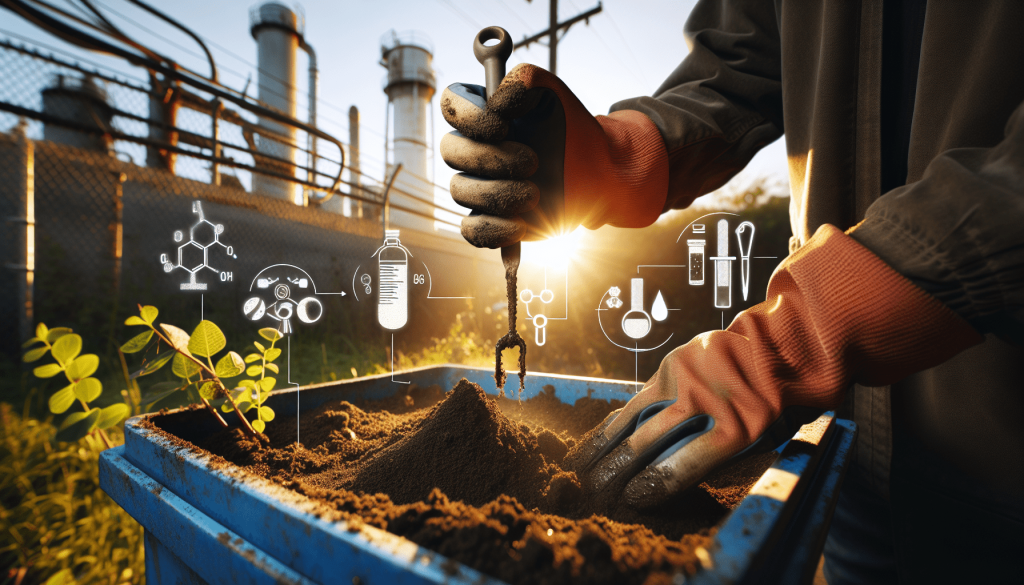This post may contain affiliate links. As an Amazon Associate, we may earn commissions from qualifying purchases.
Dive into the essential guide “Understanding And Managing Heavy Metal Contamination In Urban Soils,” where you’ll uncover the critical steps needed to tackle one of the most pressing environmental issues in the cityscape. You’ll explore the origins of these harmful metals, how they infiltrate the urban soil, and the best practices for assessing and mitigating their impact. By understanding how to manage these contaminants effectively, you’ll be empowered to help create safer, healthier environments in communities you care about. Have you ever wondered about the quality of soil in your backyard garden or local park in an urban area? Urban soils might look harmless, but they often harbor hidden dangers, particularly heavy metal contamination. This article delves into understanding and managing heavy metal contamination in urban soils. Let’s uncover what you need to know and what actions you can take to ensure a safer environment.

What Is Heavy Metal Contamination?
Heavy metal contamination refers to the presence of toxic heavy metals in the soil at levels that pose a risk to human health and the environment. The most common heavy metals of concern include lead (Pb), cadmium (Cd), arsenic (As), mercury (Hg), and chromium (Cr). Unlike organic pollutants, heavy metals do not degrade over time and can remain in the soil for hundreds of years, continuing to pose serious risks.
Sources of Heavy Metals in Urban Areas
Heavy metals can originate from various sources. Below are some of the most common ones in urban settings:
- Industrial Activities: Factories and workshops often release heavy metals through emissions and waste disposal.
- Traffic Emissions: Vehicles emit heavy metals like lead and cadmium from exhaust fumes.
- Pesticides and Fertilizers: Some agricultural products contain heavy metals that can leach into the soil.
- Construction and Demolition: Building materials, paints, and pipes may contain heavy metals that become part of the soil when structures are demolished.
Why Is Heavy Metal Contamination Concerning?
Heavy metal contamination is a significant issue due to its potential impact on human health and the environment. Consuming plants grown in contaminated soil or coming into direct contact with the soil can lead to heavy metal ingestion. This can cause a variety of health issues, including:
- Neurological Problems: Metals like lead are known to affect brain development, especially in children.
- Kidney Damage: Heavy metals such as cadmium can cause severe kidney problems.
- Respiratory Issues: Inhalation of contaminated soil particles can cause chronic respiratory diseases.
Methods for Detecting Heavy Metal Contamination
Detecting heavy metal contamination in soil requires a multi-step approach. Below are some techniques that are commonly used:
Soil Sampling and Laboratory Analysis
Soil samples are collected from multiple locations and depths within the suspected contaminated area. These samples are then analyzed in a laboratory using techniques like Atomic Absorption Spectroscopy (AAS) or Inductively Coupled Plasma Mass Spectrometry (ICP-MS).
In-Situ Testing
Portable X-ray fluorescence (XRF) analyzers can provide real-time data on heavy metal concentrations directly in the field, making them highly useful for preliminary assessments.
Bioindicators
Certain plants and microorganisms are hyper-accumulators of heavy metals. Their presence and health can be indicative of soil contamination levels.
Risk Assessment Models
Once contamination has been detected, risk assessment models like the Contaminated Land Exposure Assessment (CLEA) model can be used to evaluate potential health risks associated with the contamination.
Here’s a simplified table to summarize the detection methods:
| Method | Description | Advantages | Disadvantages |
|---|---|---|---|
| Soil Sampling & Lab Analysis | Collecting soil and analyzing it in a lab | Highly accurate and comprehensive | Time-consuming, expensive |
| In-Situ Testing | Using portable devices for on-site analysis | Quick, can cover large areas | Less accurate than lab tests |
| Bioindicators | Using plants or microorganisms to indicate contamination | Non-invasive, cost-effective | Requires specialized knowledge |
| Risk Assessment Models | Using models to evaluate health risks associated with contamination | Helps in understanding risk levels | Requires existing contamination data |
Managing Heavy Metal Contamination
Once contamination has been identified, the next step is managing it effectively. There are several strategies for managing heavy metal contamination in urban soils.
Phytoremediation
Phytoremediation involves using plants to absorb heavy metals from the soil. Hyperaccumulators like sunflowers and mustard plants are particularly effective. This method is environmentally friendly and cost-effective but can take several growing seasons to produce significant results.
Soil Excavation and Replacement
In extreme cases, the contaminated soil can be excavated and replaced with clean soil. While highly effective, this method is expensive and may not be feasible for large areas.
Chemical Stabilization
Chemical additives like lime and phosphate can be added to contaminated soil to bind heavy metals and reduce their mobility. This method can quickly reduce the risk of heavy metal leaching but does not remove the metals from the soil.
Community Action and Policy Changes
Raising public awareness and advocating for policy changes are crucial in managing heavy metal contamination. Community groups can push for routine soil testing in urban areas and stricter regulations on industrial emissions, traffic, and the use of hazardous materials.
Here’s another table summarizing remediation methods:
| Method | Description | Advantages | Disadvantages |
|---|---|---|---|
| Phytoremediation | Using plants to absorb heavy metals | Environmentally friendly, cost-effective | Slow process |
| Soil Excavation & Replacement | Removing contaminated soil and replacing it with clean soil | Highly effective | Very expensive, disruptive |
| Chemical Stabilization | Adding chemicals to bind heavy metals and reduce mobility | Quick, reduces leaching risk | Does not remove metals, costly in the long-term |
| Community Action & Policy Changes | Grassroots efforts to promote testing and enforce regulations | Long-term impact, fosters community engagement | Requires significant effort and time |
Practical Steps You Can Take
You don’t need to be a soil scientist to help manage and reduce heavy metal contamination in your urban environment. Here are some practical steps you can take:
Routine Testing
Regular soil testing in your garden or community parks can provide valuable information about contamination levels. This allows you to take appropriate action when necessary.
Organic Farming Practices
Using organic fertilizers and pesticides can reduce the introduction of new contaminants into the soil. Compost and mulch improve soil health and reduce the bioavailability of heavy metals.
Growing Safe Crops
Certain crops, like tomatoes and corn, absorb less heavy metal from soil compared to leafy vegetables. Opt for these safer alternatives when growing your own food in urban gardens.
Education and Advocacy
Educate your neighbors and local officials about the risks of heavy metal contamination. Advocate for stricter regulations and better urban planning to reduce exposure and manage existing contamination.
Soil Amendments
Adding organic matter like compost or biochar can help immobilize heavy metals in the soil, making them less available for plant uptake. This improves soil health overall and can reduce contamination risks.

The Role of Governments and Institutions
Governments and public institutions play a critical role in managing heavy metal contamination. Here are some initiatives they can undertake:
Policy Implementation
Enforcing stricter regulations on industrial emissions, recycling of electronic waste, and limiting the use of heavy metals in construction materials can significantly reduce new sources of contamination.
Public Health Programs
Public health initiatives should include regular monitoring of urban soils, coupled with public awareness campaigns to educate citizens about the risks and methods of risk mitigation.
Funding Research
Funding research into advanced soil remediation technologies and risk assessment models can help in developing more efficient and cost-effective methods for managing heavy metal contamination.
Urban Planning
Incorporating green spaces, installing barriers, and promoting the use of clean technologies in urban planning can help reduce the risk of heavy metal contamination in densely populated areas.
Case Studies
Studying real-world examples can provide valuable insights into effective strategies for managing heavy metal contamination. Let’s look at two notable cases:
Flint, Michigan, USA
Flint, Michigan, became infamous for its water crisis, but soil contamination was also a pressing issue. High levels of lead were found in residential soils, primarily from industrial emissions and old lead-based paints. The city implemented soil replacement programs in the most affected areas and increased public awareness about safe gardening practices.
Guiyu, China
Guiyu is one of the largest e-waste processing sites in the world and suffers from severe heavy metal contamination in its soils. The Chinese government has since enforced stricter e-waste recycling laws, relocated many processing sites, and initiated large-scale phytoremediation projects to mitigate the contamination.
Future Outlook
As urbanization continues, managing heavy metal contamination in soils will remain a critical task. Advances in technology, coupled with robust policy frameworks, can pave the way for more sustainable urban living.
Technological Advancements
Emerging technologies like nanoremediation and bioremediation using genetically modified organisms (GMOs) offer promising solutions for faster and more effective soil cleaning.
Public Engagement
Increased public awareness and community involvement will be crucial in ensuring long-term success in managing urban soil contamination. Grassroots movements can play a pivotal role in influencing policy changes and encouraging sustainable practices.
Sustainable Urban Development
Designing cities with green infrastructures, such as rain gardens and urban forests, can help filter out pollutants and reduce the risk of heavy metal contamination. Additionally, promoting sustainable agricultural practices within cities can ensure that urban farming remains safe and productive.
Conclusion
Understanding and managing heavy metal contamination in urban soils is a complex yet crucial task. By identifying sources of contamination, employing effective detection and remediation methods, and advocating for policy changes, you can play a vital role in creating healthier urban environments. Don’t wait for a crisis to act—start testing, educating, and advocating today. With collective effort and sustainable practices, we can mitigate the risks of heavy metal contamination and enjoy safer, greener urban spaces for generations to come.








